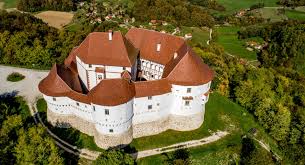Your basket is currently empty!
Perched atop a picturesque hill in the Croatian Zagorje region, Veliki Tabor Castle stands as a majestic testament to centuries of history, architectural evolution, and captivating folklore. This imposing fortress, with its distinctive pentagonal tower and formidable walls, offers a compelling journey through medieval times, Renaissance elegance, and the enduring power of local legends. As a prominent cultural monument, Veliki Tabor is not merely a structure of stone and mortar; it is a living narrative that continues to intrigue historians, tourists, and enthusiasts of the macabre alike. Its strategic location provided panoramic views and defensive advantages, making it a crucial stronghold throughout its active life.
The castle’s origins stretch back to the 12th century, with its earliest sections believed to have been constructed around that period. However, the majority of its current appearance dates from the 15th and 16th centuries, particularly under the ownership of the influential Counts of Celje and later the Rattkay family. The Rattkays, who owned the castle for over three centuries, significantly expanded and adapted it, transforming it from a purely defensive fort into a more comfortable noble residence while retaining its impressive fortifications. This blend of military robustness and residential grandeur is a hallmark of Veliki Tabor’s architectural style. Its different construction phases are clearly visible, showcasing various architectural trends from Gothic to Renaissance elements.

Veliki Tabor’s historical significance extends beyond its architectural prowess. It played a vital role in regional defense, particularly against Ottoman incursions, safeguarding the heartland of Croatia. The castle’s thick walls and strategic placement offered a critical line of defense during turbulent periods. Beyond warfare, it served as an administrative and economic center for the surrounding estates, influencing the lives of countless people in the region. Over the centuries, the castle has changed hands numerous times, each owner leaving their mark on its structure and story. Today, it operates as a museum, carefully preserving artifacts and exhibits that chronicle its rich past, offering visitors a glimpse into the daily lives of its former inhabitants and the broader historical context of the region.
However, no discussion of Veliki Tabor Castle is complete without mentioning the haunting legend of Veronika Desinić. This tragic tale speaks of a beautiful commoner, Veronika, who fell deeply in love with Frederick II of Celje, son of Herman II, a powerful nobleman and owner of the castle. Their forbidden love, deemed unsuitable by Frederick’s father, led to a dramatic and sorrowful end. According to the legend, Herman II, enraged by his son’s defiance, ordered Veronika to be drowned and then immured alive within the castle walls as a brutal punishment. Her ghost is said to still wander the castle corridors, her cries sometimes heard on windy nights, forever tied to the place of her demise. This poignant story adds a layer of mystique and romance to the castle, drawing visitors who are equally captivated by its history and its enduring supernatural lore.
Veliki Tabor Castle is more than just an ancient building; it is a captivating fusion of Croatia’s rich past, architectural evolution, and the timeless power of human emotion and legend. Its well-preserved structure, historical exhibitions, and the persistent whispers of Veronika’s tragic fate ensure its place as one of Croatia’s most compelling cultural landmarks. For those seeking a unique blend of history, architecture, and a touch of the supernatural, a visit to Veliki Tabor Castle promises an unforgettable experience, making it a must-see destination for anyone exploring the heart of Croatia.

